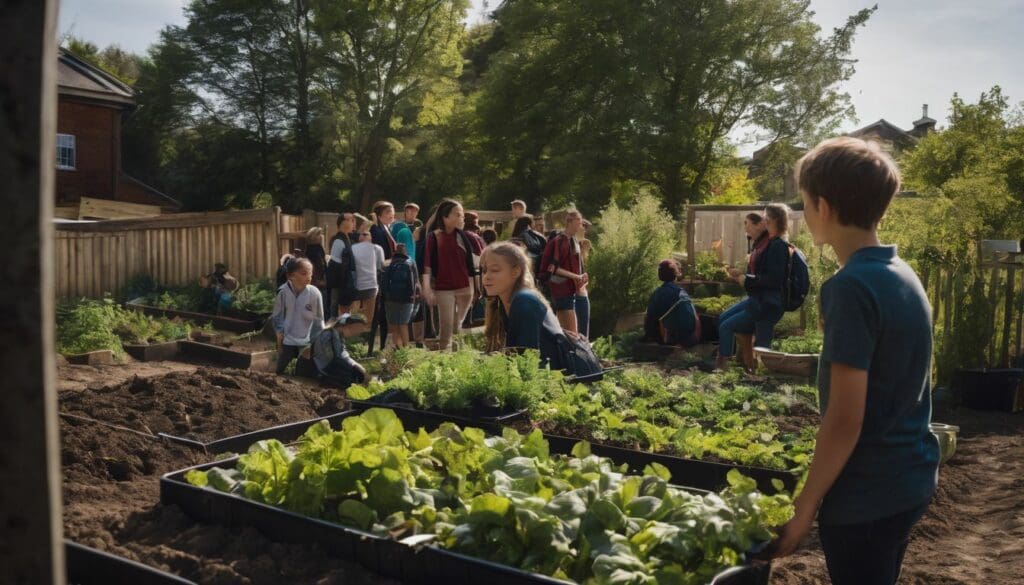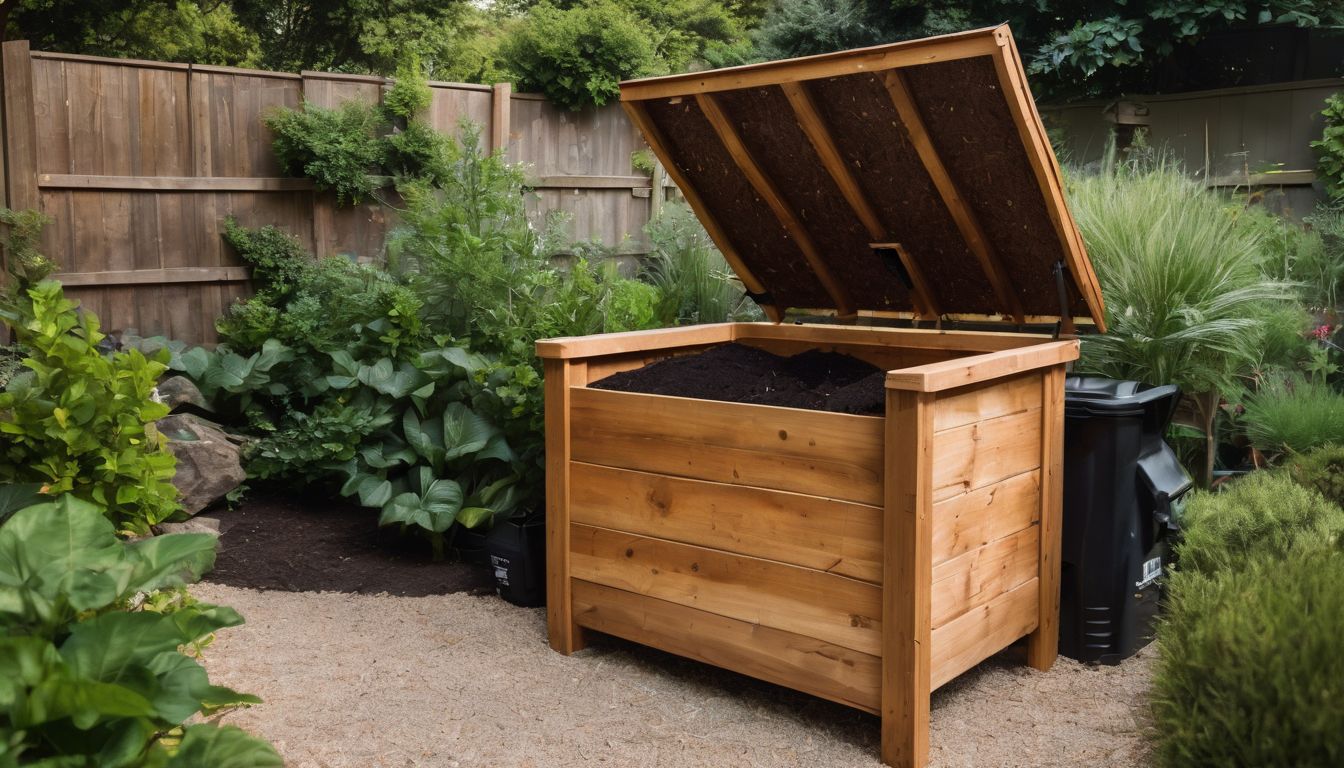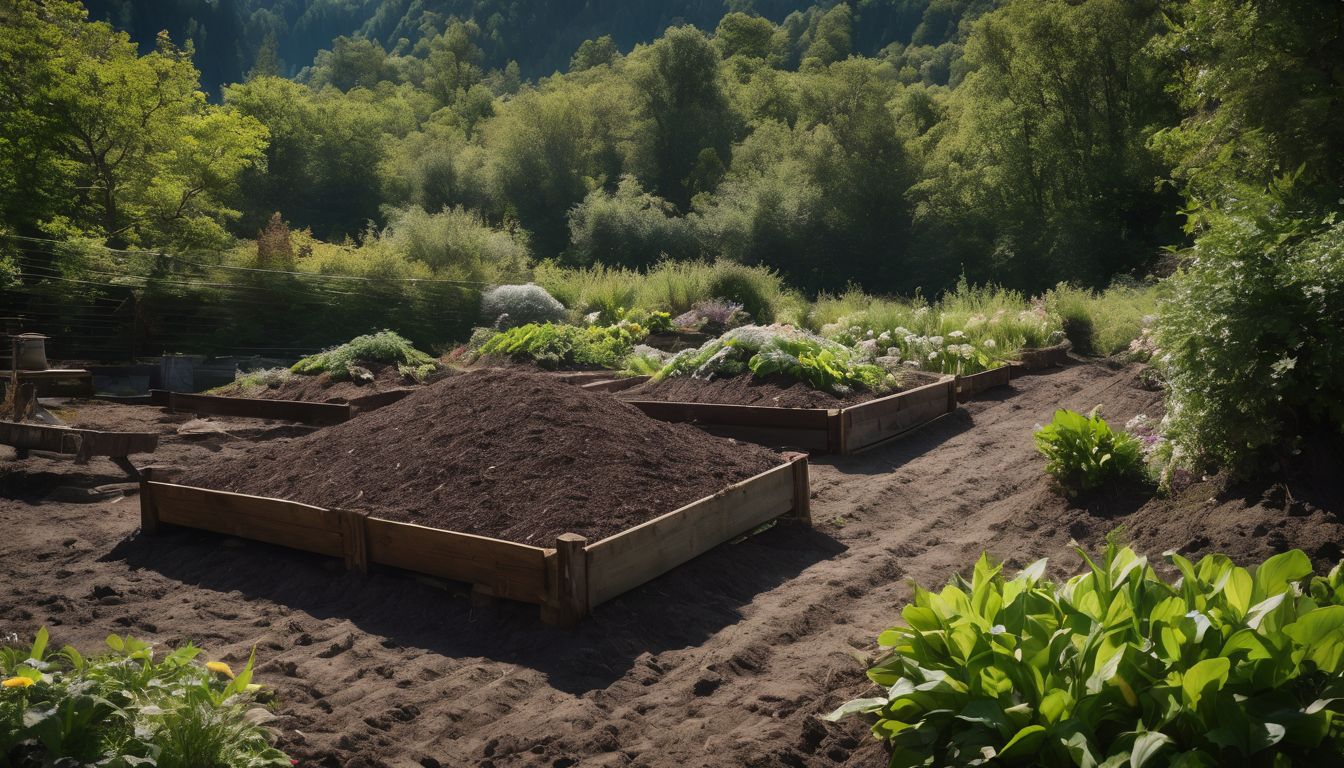Schools are constantly seeking new ways to educate about sustainability. In the UK alone, food waste in schools amounts to an estimated 123,000 tonnes each year. Our blog will guide you through transforming school lunch scraps into valuable lessons on environmental stewardship.
Let’s dig in!
Key Takeaways
- Composting in schools can dramatically reduce the 123,000 tonnes of food waste generated annually by teaching students valuable lessons on environmental stewardship through practical experience.
- School composting programs not only improve soil quality and aid plant growth but also instil responsibility and encourage an ecological mindset among students as future custodians of the planet.
- By engaging in science lessons about decomposition, math activities tracking compost progress, and art projects that reuse materials for bin construction, students gain a multifaceted educational experience connected to real-world sustainability challenges.
- Decision-making between on-site or off-site composting options involves considering space availability, resources, potential community partnerships, and the desired level of student involvement.
- Utilising a variety of tools like videos, worksheets, signs and presentations alongside student-based curriculum planning ensures that school composting initiatives are both informative and engaging.
Benefits of Incorporating Composting into School Curriculums
Incorporating composting into school curriculums reduces food waste, improves soil quality, and teaches students about sustainability. It provides hands-on environmental learning and encourages waste reduction through organic waste management.
Reduces food waste
Engaging students in composting activities at school puts a big dent in food waste. Lunch scraps and leftover organic materials from the canteen no longer end up rotting away in landfills.
Instead, these bits of uneaten fruit, vegetable peels, and bread crusts transform into nutrients for the school garden’s soil. By turning yesterday’s apple cores into tomorrow’s fresh produce, schools champion waste reduction while closing the loop on their own ecological systems.
Composting as part of a student-based curriculum empowers young minds to take charge of waste management proactively. Through hands-on environmental projects, they see firsthand how their banana skins and potato wedges avoid becoming trash.
They learn valuable lessons about sustainability by converting what used to be thrown away into rich compost that boosts soil health for plants around campus. This practical approach ensures organic waste serves a new purpose instead of contributing to our planet’s growing rubbish problem.
Improves soil quality
Implementing composting in school curriculums enhances soil quality. Composting enriches the soil with essential nutrients, promoting healthier plant growth and increased biodiversity.
It also aids in retaining moisture, thereby reducing the need for irrigation and preventing soil erosion. By integrating composting into school programs, students gain hands-on experience in sustainable practices, fostering a deeper understanding of environmental conservation.
Integrating composting into the curriculum not only improves soil quality but also instills a sense of responsibility towards the environment. Next, let’s explore how teaching about sustainability through composting can benefit students beyond just improving soil quality.
Teaches students about sustainability
Improves soil quality by introducing students to the concept of sustainability. Through composting, students learn about the environmental impact of food waste and the benefits of recycling organic materials.
With hands-on experience, they gain a deep understanding of how composting contributes to preserving natural resources and reducing landfill waste. In turn, this fosters an ecological mindset among students, empowering them to take meaningful action towards a more sustainable future.
Encourages critical thinking by engaging students in practical activities that highlight the interconnectedness between human actions and the environment. These experiences instill a sense of responsibility for protecting our planet and nurturing it for future generations.
Curriculum Ideas for Composting in Schools
Incorporating composting into school curriculums can be integrated into multiple subjects, such as science and math. Students can learn about decomposition, the role of compost in soil, and measure and track composting progress through hands-on activities.
Additionally, art projects using recycled materials to create compost bins can also be a fun way for students to engage with composting.
Science lessons on decomposition and the role of compost in soil
- Exploring different types of organic matter and their decomposition rates
- Conducting experiments to observe and compare composted and non – composted soil
- Discussing the environmental benefits of using compost as a natural fertiliser
- Engaging in hands-on activities to demonstrate the process of composting in small-scale setups
Math lessons on measuring and tracking composting progress
Art projects using recycled materials to create compost bins
Engage students in hands-on environmental projects by incorporating art projects using recycled materials to create compost bins. This activity not only promotes creativity but also teaches the importance of waste to resource conversion and sustainability in education.
- Students can use old containers, cardboard, or wooden pallets to build the structure of the compost bin, ensuring they understand the principles of reusing and repurposing materials.
- Encourage students to decorate the bins with eco – friendly paints and materials, emphasising the concept of upcycling while creating visually appealing composting systems.
- Introduce a design challenge where students have to incorporate specific elements such as aeration holes, access doors, and drainage systems into their compost bin designs, promoting critical thinking and problem-solving skills.
- Organise a showcase or exhibition where students present their compost bin designs to the school community, highlighting the connection between art, environmental education, and sustainable practices.
Tools and Resources for Schools to Implement Composting
Equip your school with videos, worksheets, and posters to engage students in composting activities and educate them on the benefits of waste reduction – read on to discover more about incorporating composting into school curriculums.
Videos and presentations on composting and its benefits
- Videos can demonstrate the process of composting, showing how organic waste breaks down into nutrient-rich soil amendment.
- Presentations can highlight the environmental impact of composting, emphasising its role in reducing greenhouse gas emissions and preserving natural resources.
- Guest speakers from local composting facilities can share real – life examples and success stories with students, inspiring them to get involved in sustainable practices.
Worksheets and games to engage students in composting activities
To engage students in composting activities, schools can provide interactive worksheets and games that promote hands-on learning and environmental awareness. Students can participate in fun activities such as word searches, crossword puzzles, and matching games to learn about the process of composting and its impact on soil conservation. Additionally, they can complete fill-in-the-blank worksheets that require them to identify different types of organic waste suitable for composting, reinforcing their understanding of sustainable practices.
Signs and posters to educate students and staff on composting practices
After engaging students in composting activities through worksheets and games, using signs and posters to educate students and staff on composting practices can further reinforce the importance of composting in schools. Utilising catchy slogans and vibrant visuals, these signs and posters can be strategically placed in school cafeterias, hallways, and waste disposal areas to promote proper composting habits.
- Clear instructions: Create signs with step-by-step instructions on how to separate organic waste from other rubbish and where to deposit it.
- Educational infographics: Design posters featuring infographics that explain the process of composting, its environmental benefits, and the impact of food waste.
- Composting facts: Incorporate interesting facts about composting on the signage to engage students and staff in learning more about sustainable waste management.
- Interactive bulletin boards: Establish interactive bulletin boards that display changing information related to composting initiatives, such as current compost levels or success stories from other schools.
- Reminder signage: Install reminders near common areas for disposing of waste, serving as daily prompts for environmentally-friendly actions.
- Student-created artwork: Encourage students to create their own educational artwork related to composting that can be displayed throughout the school premises.
Implementation of School Composting Programs
Deciding between on-site or off-site composting is an important step in implementing a school composting program. Designing and building a composting system, as well as developing a student-based curriculum and compost activities, are crucial for success.
Deciding between on-site or off-site composting
When implementing a school composting programme, the first decision is whether to conduct the composting on-site or off-site. Each approach has its own advantages and considerations to take into account:
- On-site Composting:
- Utilises food waste directly from the school premises
- Provides hands – on learning opportunities for students in managing the composting process
- Requires space and resources for building and maintaining composting bins or systems
- Off-site Composting:
- Involves partnering with external composting facilities or local farms
- May reduce the operational responsibilities for the school staff
- Requires transportation arrangements for collecting and delivering food waste to the off-site facility
- Considerations:
- Assess the available space and resources within the school grounds
- Evaluate potential partnerships with local community composting initiatives
- Determine the level of involvement desired from students in managing the composting process, considering educational objectives
- Decision-making Process:
- Engage stakeholders such as administrators, teachers, parents, and students in discussions about on-site versus off-site options
- Consider environmental impact, educational value, logistical feasibility, and cost implications of each approach before making a decision
Designing and building a composting system
Designing and building a composting system involves several key steps to ensure its effectiveness and sustainability.
- Choose the appropriate location for the composting system, considering access to organic waste materials, sunlight, and water source.
- Select the type of composting method that suits the school’s needs, such as traditional compost bins, vermicomposting (using worms), or tumblers.
- Determine the necessary size and capacity of the composting system based on the amount of organic waste generated by the school.
- Source suitable materials for constructing the composting system, such as recycled wood for bins or purchasing ready-made composting units.
- Incorporate aeration and drainage components into the design to facilitate proper decomposition of organic matter.
- Educate staff and students on how to use and maintain the composting system effectively, ensuring it becomes an integral part of school sustainability efforts.
Developing a student-based curriculum and compost activities
To incorporate composting into school curriculums, students can actively engage in various activities and lessons related to composting and sustainability.
- Engage students in hands – on composting activities by involving them in the process of creating and maintaining compost bins.
- Encourage project – based learning by assigning students tasks that involve measuring and tracking the progress of composting materials.
- Integrate art projects using recycled materials to design and decorate compost bins, promoting creativity and environmental consciousness.
- Foster a student-based curriculum by involving students in decision-making processes regarding composting practices at the school.
Reporting and Evaluating Compost Operations in Schools
Encouraging students to track the impact of their composting efforts and reflect on their progress, as well as utilising provided resources and guides for school composting programs.
Encouraging students to track the impact of their composting efforts
Encouraging students to monitor and assess the effects of their composting endeavours is essential for fostering a sense of responsibility and understanding of sustainability. Here are some ways to achieve this:
- Engage students in hands – on activities such as measuring and documenting the volume and weight of compost materials regularly.
- Encourage students to conduct soil tests before and after using the compost to witness the improvement in soil quality firsthand.
- Assign students to gather feedback from other students, teachers, and staff on the changes they notice in the school environment due to composting efforts.
- Organise group discussions or presentations where students can share their findings and observations regarding the impact of their composting initiatives.
- Foster a culture of environmental stewardship by celebrating student achievements through awards or recognition programmes linked to successful composting outcomes.
- Create opportunities for students to collaborate with local community members, scientists, or environmental organisations for a broader perspective on the impact of their actions.
- Integrate reflection exercises into the curriculum that prompt students to contemplate how their individual efforts contribute to larger environmental goals.
Reflection questions to assess the success of the program
To assess the success of the composting programme in schools, reflection questions can be utilised as a tool for evaluation. Here are some sample reflection questions for assessing the success of the programme:
- How has the composting programme impacted our school’s waste reduction efforts?
- What changes have been observed in the soil quality in areas where compost has been used?
- In what ways has student engagement with environmental conservation been influenced by participating in the composting programme?
- What challenges have we encountered in implementing and maintaining the composting initiative, and how have we addressed them?
- How have students demonstrated an understanding of sustainable practices through their involvement in the composting programme?
- What measurable improvements have occurred in our school’s environmental footprint as a result of the composting initiative?
Utilizing provided resources and guides for school composting programs
- Videos and presentations offering comprehensive information on composting methods and its environmental benefits, enhancing students’ understanding of the importance of waste reduction and soil enrichment.
- Engaging worksheets and games designed to involve students actively in composting activities, making learning fun while reinforcing their knowledge of sustainable practices.
- Signs and posters providing educational material on composting practices, effectively raising awareness among students and staff about the significance of responsible waste management.
- Access to hands – on environmental projects such as creating school gardens or designing composting systems, allowing students to actively participate in practical applications of sustainability principles.
Conclusion
In conclusion, integrating composting into school curriculums benefits both the environment and students. Students learn about sustainability and contribute to reducing food waste.
Implementing hands-on environmental projects and project-based learning through on-site or off-site composting enhances their understanding of the impact they can make. By incorporating curriculum ideas that cover science, maths, art, and utilising available tools and resources, schools can successfully implement composting programs.
FAQs
1. What does incorporating composting into school curriculums involve?
Incorporating composting involves adding hands-on environmental projects, like onsite and offsite composting, to lessons so students can learn the importance of waste reduction right at their school.
2. How can schools start a composting project?
Schools can jumpstart composting projects by integrating them into the curriculum through project-based learning and activities like lunchbox audits or starting a school garden.
3. Why should composto be part of student-based curriculum?
By making composting a part of the student-based curriculum, kids actively participate in eco-friendly practices, turning everyday waste into valuable resources for their garden or other green spaces.
4. Will students only read about compositng when it’s in their curriculum?
No, they won’t just read about it; students will get hands-on experience with how to create and maintain a composter as well as understand its benefits for the environment through active learning.





